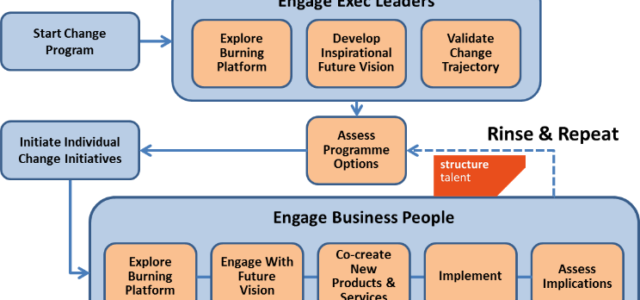Necessity is the Mother of Invention. Unless something is truly necessary, there is no need for it. It is one of the reasons that wars drive such a pace of innovation. Creating new ways to win becomes absolutely necessary when you are in a fight for survival. People have to focus on the threat and find new ways to overcome it.
Conflict is horrible but it does drive innovation.
The phone on which you’re probably reading this article can trace it’s roots back to the first computers, amongst them the machine built to crack the Enigma Code. A machine that was created to win a war.
So if necessity is the mother of all invention and it is a universal principle – how can leaders use it?
How can they use it to improve themselves and their people?
I have written about the focus curve before but I used it to explain ‘Why companies don’t need to build resilience’.
In this article, I am going to explain how you can use it to improve the performance of your people – and even yourself. I believe that it is one of the core leadership principles because if a leader doesn’t improve the capability of his team – they hasn’t improved the situation for his/her people.
The focus curve is simply a bell curve with ‘burn out’ and ‘rust out’ on either side.
Most people oscillate on this curve moving from one end to the other. Ideally, they want to be between the yellow lines.
Problems arise when people get stuck at one end for too long.
When people win the lottery, one of the things that they will be offered in their package of support is a therapist. It might sound strange but once you’ve won the lottery, a large proportion of your basic needs are going to be taken care of. You’ll probably quit your job and take some time off which is fair enough.
But for many, that can create an environment of loneliness. Why bother getting up in the morning and going to work if you’ve got all your needs taken care of? This might sound great to some but ‘rusting out’ is as bad for us as ‘burning out’.
It is the reason that wealth is often responsible for killing ambition.
Why bother working hard if the bank of Mum and Dad will pick up the bills?
It’s also the reason why many people die relatively quickly after they retire. Work has given them a challenge, a reason to get up and ‘get after something’.
Humans are designed to do this. Your ancestors survived to pass on their genes because they survived the challenges they faced. Without challenge, we struggle to perform because we are designed to overcome.
So how do you use this approach to your advantage – How do you make it work in your favour?
The RAF do it intuitively when they train their fast-jet pilots – and the key is ensuring that people continually oscillate in the right area.
When you learn how to fly, you start off in a relatively small, lightly powered aircraft to learn the basics. You immediately move towards ‘burn-out’ because learning a new skill can be a challenging and stressful situation.
Remember when you learnt to drive, how fast everything seemed and how easy it was to stall?
This is same experience you go through as you learn to fly.
Gradually, you start to get used to it though. You develop as you learn and you start to build the skills required to fly the plane. You start to move back to the top of the curve. Once you can fly a small aircraft, you are tested and graded. If you’re good enough, you go on to fly fast-jets.
The RAF then take you through the process again. In order to move you back towards ‘burn out’, and help you develop, they throw more power into the equation.
Increasing the power of the aircraft reduces the time you have to react. Suddenly, what worked before when you had time, no longer works. You have to adapt to the change in the environment – and that is how you learn.
It is the same process that Formula One drivers go through. They start with Go-Karts before graduating to drive more powerful vehicles.
Once the pilot has mastered the Tucano, they learn to fly a hawk and then finally a fast-jet. Once they can fly a fast-jet and have spent time as a frontline pilot, they go on to teach and the cycle repeats.
This is how you develop into a world-class pilot. It’s not an accident. It is the result of a structured process that challenges the individual to improve.
This is a principle because it can be universally applied to any type of development, you just need to learn how. In the Workplace
In the Workplace
If you have been doing the same job for four years, you have probably reached a level where you are competent. What if you do the job for another four years? Do you become twice as competent? I would argue not. Unless the role changes significantly, you are likely to be doing very similar tasks.
Now, there is nothing wrong with that and for some people they will be very happy with that situation. The point I am trying to make is that after a period of time, the ‘learning curve tails’ off and repetition starts to creep in.
I have worked with people who have proudly claimed that they have ‘twenty years of experience’ in doing a job.
But the reality is that it takes two years to get competent so it is fairer to say that they have ‘ten lots of two years worth of experience’ which is not the same thing.
If organisations want their people to perform, they have to ‘make it necessary’ for them to learn and develop. Changing roles pushes people out of their comfort zone making it necessary for them to pick up new skills and adapt to changing circumstances.
Doing the same role for years, doesn’t help an individual’s development. It also prevents someone else from moving into that role and using it to develop their skills.
This is why it is better to create a culture of internal turnover. After someone has done a job for two to three years, the organisation and the individual should be looking to make a change. They should be proactively looking to do this before the individual becomes stagnant and moves into the rust-out zone.
The point that I’m making here is that the comfort zone will kill your creativity in the long-term because once you’ve mastered the job, the ‘need to learn’ is extinguished.
If you aren’t learning, if you aren’t forced to adapt to new circumstances and change – you are dying. The rust-out zone will kill you just as quickly as ‘the burn-out zone’.
Humans need struggle to thrive. They need to be challenged and pushed to develop new skills.
But you don’t have to change jobs to develop new skills. Physical pursuits and hobbies can help you to develop.
If you want to learn about behavioural change – try changing your body. Try adding muscle or losing weight. The skills required to do this involve changing the way you behave. Learning how to do this, how to build and break habits is one of the most valuable things you can learn. Once you’ve cracked it, you can apply it to other areas of behaviour you want to change.
This is how you build character.
For example, you can’t build willpower sat in front of the TV. You have to stress the system to create the conditions required for a change to happen.
See how far you can run without stopping. Then rest for a few days and do it again. Keep doing it until you can run 10km. Then plan to do a marathon and use the same principle to work up to it.
Increasing your running mileage is a simple way of implementing this principle. You are stressing the body so that it has to change and adapt. You are making it necessary to become fitter.
This principle can be applied to any form of development.
Create the conditions to make change necessary. Stress the system and allow it to recover.
It is how the best pilots in the world are trained.
It is a principle you can use to become the best at whatever you want to be.
Article by channel:
Everything you need to know about Digital Transformation
The best articles, news and events direct to your inbox
Read more articles tagged: Featured, Leadership












